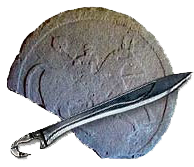Autor: JM0005
miércoles, 01 de febrero de 2006
Sección: De los pueblos de Celtiberia
Información publicada por: JM0005
Mostrado 14.712 veces.
Famous ‘Celtic’ nations may be misnamed Genetic studies hint at unexpected origins of clans...
Famous ‘Celtic’ nations may be misnamed Genetic studies hint at unexpected origins of clans.
DUBLIN, Ireland - Celtic nations like Ireland and Scotland have more in common with the Portuguese and Spanish than with “Celts” — the name commonly used for a group of people from ancient Alpine Europe, scientists say...
Famous ‘Celtic’ nations may be misnamed Genetic studies hint at unexpected origins of clans.
Famous ‘Celtic’ nations may be misnamed Genetic studies hint at unexpected origins of clans.
Updated: 7:44 p.m. ET Sept. 9, 2004
DUBLIN, Ireland - Celtic nations like Ireland and Scotland have more in common with the Portuguese and Spanish than with “Celts” — the name commonly used for a group of people from ancient Alpine Europe, scientists say.
“There is a received wisdom that the origin of the people of these islands lie in invasions or migrations ... but the affinities don’t point eastwards to a shared origin,” said Daniel Bradley, co-author of a genetic study into Celtic origins.
Early historians believed the Celts — thought to have come from an area to the east of modern France and south of Germany — invaded the Atlantic islands around 2,500 years ago.
But archaeologists have recently questioned that theory, and now Bradley, from Trinity College Dublin, and his team, say DNA evidence supports their thinking.
Geneticists used DNA samples from people living in Celtic nations and compared the genetic traits with those of people in other parts of Europe.
The study showed that people in Celtic areas — Wales, Scotland, Ireland, Brittany and Cornwall — had strong genetic ties, but that this heritage had more in common with people from the Iberian Peninsula.
“What we would propose is that this commonality among the Atlantic facade is much older ... 6,000 years ago or earlier,” Bradley told Reuters.
He said people may have moved up from areas around modern-day Portugal and Spain at the end of the Ice Age.
The similarities between Atlantic “Celts” could also suggest these areas had good levels of communications with one another, he added.
But the study could not determine whether the common genetic traits meant “Celtic” nations would look alike or have similar temperaments. Dark or red hair and freckles are considered Celtic features.
Copyright 2006 Reuters Limited. All rights reserved. Republication or redistribution of Reuters content is expressly prohibited without the prior written consent of Reuters.
No hay imágenes relacionadas.
Comentarios
 Pulsa este icono si opinas que la información está fuera de lugar, no tiene rigor o es de nulo interés.
Pulsa este icono si opinas que la información está fuera de lugar, no tiene rigor o es de nulo interés.
Tu único clic no la borarrá, pero contribuirá a que la sabiduría del grupo pueda funcionar correctamente.
Si te registras como usuario, podrás añadir comentarios a este artículo.

Buf, al igual se piensan que han descubierto la sopa de ajo estos genetistas... El caso es que si no se tiene en cuanta que genes = lengua no concuerda al 100% (vease Perú por ejemplo), y no se tiene en cuenta la expansión de clanes paleolíticos después de la glaciación para colonizar nuevas tierras libres (imposible de colonizar por los pocos clanes locales que a la fuerza deberían ser de muy reducido número en caso de existir), o que el neolítico avanzó por mar (vaya, junto al megalitismo) llegando a las islas a eso del 4200 aC supuestamente con la ruta Sur de Portugal - Bretaña - Gran Bretaña... que no se sorprendan; y menos si no computan migraciones (y más genes ) continentales célticas y germanas que afectaron fundamentalmente Inglaterra pero de las que se libraron en buena medida las naciones "celtas".
Hay 1 comentarios.
1